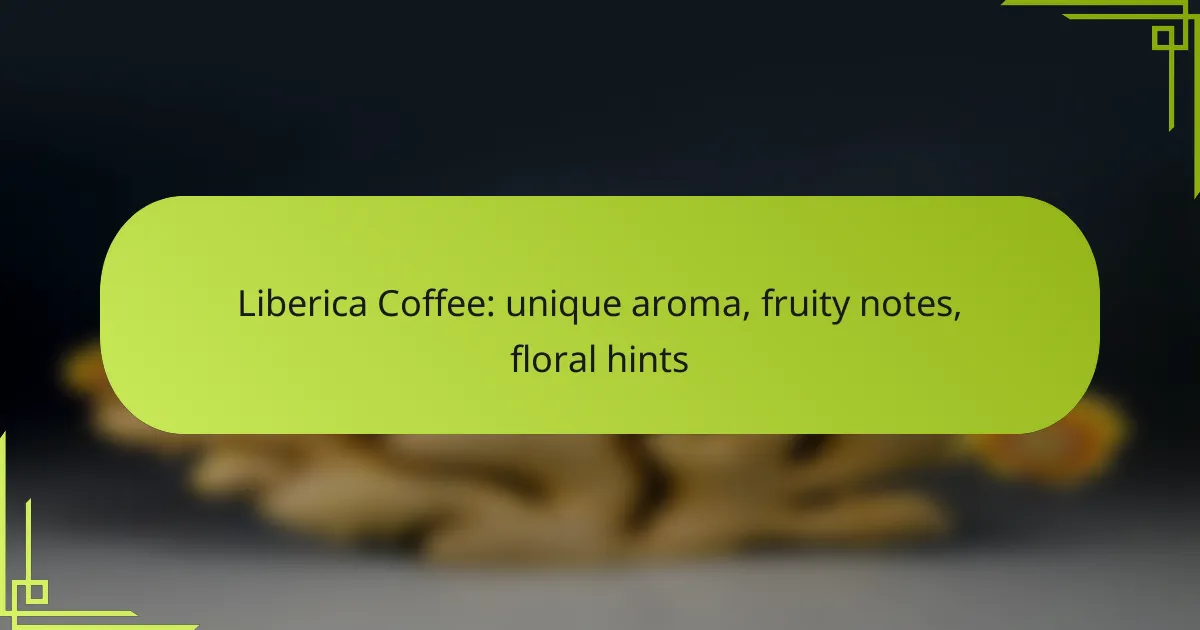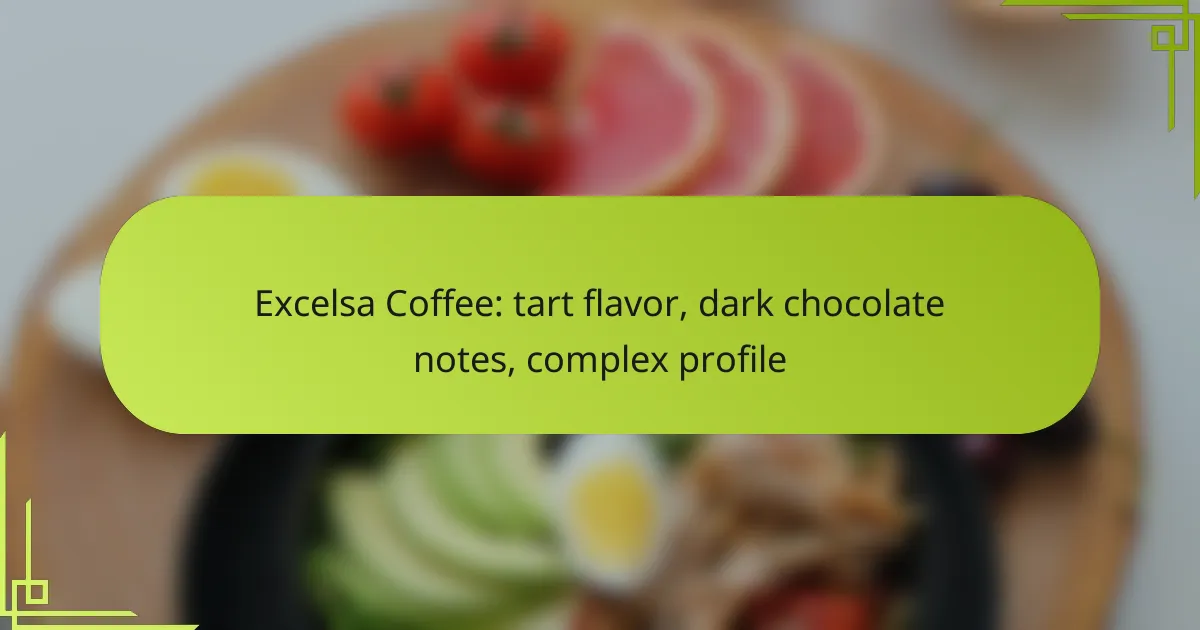Liberica coffee stands out with its unique flavor profile, characterized by a bold taste and a complex blend of fruity and floral notes. Unlike the more widely known Arabica and Robusta varieties, Liberica offers a rare and intriguing experience for coffee enthusiasts, making it a delightful choice for those seeking something different. Proper brewing techniques can further enhance its distinctive aroma and rich complexity.

How does Liberica coffee differ from other coffee types?
Liberica coffee is distinct from other coffee varieties due to its unique flavor profile and aroma. Unlike the more common Arabica and Robusta beans, Liberica offers a bold taste with a complex mix of fruity and floral notes, making it a rare choice among coffee enthusiasts.
Unique aroma profile
The aroma of Liberica coffee is often described as woody and smoky, setting it apart from other types. This unique scent is attributed to the beans’ larger size and irregular shape, which contribute to a more pronounced fragrance during brewing.
Fruity and floral notes
Liberica coffee is known for its vibrant fruity and floral notes, which can include hints of dark fruits like berries and tropical flavors. These characteristics create a complex taste profile that can surprise and delight coffee drinkers.
When tasting Liberica, one might notice a blend of citrus and floral undertones, which can vary depending on the specific growing conditions. This diversity makes each cup of Liberica coffee a unique experience, appealing to those who enjoy exploring different flavor dimensions.
Growing regions in Southeast Asia
Liberica coffee is primarily grown in Southeast Asia, with significant production in countries like the Philippines, Malaysia, and Indonesia. These regions provide the ideal climate and soil conditions that contribute to the coffee’s distinctive flavor profile.
Farmers in these areas often cultivate Liberica alongside other coffee varieties, allowing for a rich diversity in coffee production. The unique environmental factors in Southeast Asia, such as altitude and rainfall, further enhance the characteristics of Liberica beans, making them a sought-after choice for specialty coffee markets.

What are the health benefits of Liberica coffee?
Liberica coffee offers several health benefits, primarily due to its unique composition and rich flavor profile. It is known for being rich in antioxidants and may also enhance mood, making it a popular choice among coffee enthusiasts.
Rich in antioxidants
Liberica coffee is packed with antioxidants, which help combat oxidative stress in the body. These compounds can reduce inflammation and may lower the risk of chronic diseases such as heart disease and diabetes.
When selecting Liberica coffee, look for beans that are minimally processed to retain their antioxidant properties. Brewing methods like French press or pour-over can also help preserve these beneficial compounds, enhancing both flavor and health benefits.
Potential mood enhancer
Drinking Liberica coffee may improve mood and cognitive function due to its caffeine content and unique flavor profile. The combination of fruity and floral notes can create a sensory experience that uplifts the spirit.
To maximize mood-enhancing effects, consider enjoying Liberica coffee in moderation, as excessive caffeine can lead to jitters or anxiety. Pairing it with a balanced breakfast can also help stabilize energy levels throughout the day.

How to brew Liberica coffee for the best flavor?
To brew Liberica coffee for the best flavor, focus on using the right methods and parameters that highlight its unique aroma and fruity notes. Proper brewing techniques can enhance the floral hints and overall complexity of this distinctive coffee variety.
Recommended brewing methods
For Liberica coffee, methods like pour-over, French press, and siphon brewing are highly recommended. These techniques allow for better extraction of the coffee’s unique flavors and aromas. Avoid using methods that involve high pressure, such as espresso machines, as they may overpower the delicate notes.
When using a pour-over, ensure a steady, controlled pour to evenly saturate the grounds. For French press, steeping for about four minutes will help achieve a balanced flavor profile.
Optimal grind size
The optimal grind size for brewing Liberica coffee is medium to coarse. A medium grind works well for pour-over methods, while a coarse grind is ideal for French press brewing. This grind size helps to extract the coffee’s fruity and floral characteristics without leading to over-extraction.
Experiment with grind size to find the perfect balance for your taste preferences, but generally, aim for a texture similar to sea salt for French press and granulated sugar for pour-over.
Brewing temperature tips
Brewing Liberica coffee at the right temperature is crucial for optimal flavor extraction. Aim for a water temperature between 90°C and 96°C (194°F to 205°F). This range helps to preserve the coffee’s unique aroma while extracting its complex flavors effectively.
Avoid boiling water, as it can scorch the coffee and diminish its delicate notes. Use a thermometer or a kettle with temperature control to ensure accuracy during the brewing process.

Where to buy high-quality Liberica coffee?
High-quality Liberica coffee can be found through various online retailers and local specialty coffee shops. When purchasing, consider factors such as sourcing, roast date, and customer reviews to ensure you are getting the best flavor profile.
Top online retailers
Several online retailers specialize in high-quality coffee, including Liberica. Websites like Amazon, Stumptown Coffee, and Blue Bottle Coffee often carry a selection of Liberica beans.
When buying online, check for freshness by looking for roast dates and customer feedback. Many retailers offer subscriptions, which can be a convenient way to ensure a steady supply of your favorite coffee.
Local specialty coffee shops
Local specialty coffee shops are excellent places to find high-quality Liberica coffee. These shops often source unique beans and may offer tasting sessions or brewing advice. Look for shops that emphasize single-origin coffees, as they are more likely to carry Liberica.
Ask baristas about their Liberica offerings and any specific flavor notes they highlight. Many shops also sell beans, allowing you to take home freshly roasted coffee.

What are the flavor notes of Liberica coffee?
Liberica coffee is known for its unique aroma and complex flavor profile, featuring fruity notes and floral hints. This coffee variety stands out due to its distinctive taste, often described as bold and somewhat woody, making it a favorite among adventurous coffee drinkers.
Common tasting notes
The most prevalent tasting notes in Liberica coffee include fruity flavors such as berries and citrus, alongside floral undertones reminiscent of jasmine or hibiscus. Additionally, some drinkers may detect a slight smokiness or earthy quality, which adds depth to the overall experience.
These flavor notes can vary significantly based on the processing methods used, with natural processing often enhancing the fruity characteristics, while washed methods may emphasize the floral and earthy aspects. The aroma is typically strong and fragrant, contributing to its appeal.
Flavor profiles by region
Liberica coffee is primarily grown in Southeast Asia, notably in countries like the Philippines, Malaysia, and Indonesia. Each region imparts its own unique characteristics to the coffee, influenced by local soil, climate, and cultivation practices.
For example, Liberica from the Philippines often exhibits a sweeter profile with pronounced fruity notes, while Malaysian varieties may lean towards a more robust, woody flavor. Understanding these regional differences can help coffee enthusiasts select the Liberica that best suits their palate.

How to identify authentic Liberica coffee?
Authentic Liberica coffee can be identified by its distinct aroma and flavor profile, which includes fruity notes and floral hints. Look for specific characteristics in labeling, certification, and sensory cues to ensure you are purchasing genuine Liberica beans.
Labeling and certification
When seeking authentic Liberica coffee, check for proper labeling and certifications. Look for labels indicating the origin, such as beans sourced from the Philippines or Liberia, where Liberica is primarily grown. Certifications from recognized bodies can also help confirm the authenticity of the coffee.
Additionally, consider brands that participate in fair trade or organic certifications, as these often ensure higher quality and ethical sourcing practices. These labels can provide assurance that the coffee meets specific standards.
Visual and sensory cues
Visual cues can help identify Liberica coffee. The beans are typically larger and more irregularly shaped compared to Arabica or Robusta beans. Their color ranges from light brown to dark brown, often with a unique, elongated appearance.
Sensory cues are equally important. When brewed, authentic Liberica coffee offers a complex aroma with fruity and floral notes. The taste is often described as bold and slightly woody, with a lingering aftertaste. Pay attention to these characteristics when tasting to distinguish genuine Liberica from other coffee types.

What are the best food pairings with Liberica coffee?
To enhance the unique aroma and fruity notes of Liberica coffee, consider pairing it with foods that complement its distinct flavor profile. The ideal pairings include both sweet desserts and savory dishes that balance the coffee’s floral hints and rich taste.
Complementary desserts
When selecting desserts to enjoy with Liberica coffee, opt for those that feature fruity or nutty flavors. Options like almond cake, fruit tarts, or chocolate-covered berries can enhance the coffee’s natural sweetness and complexity.
Additionally, consider lighter desserts such as panna cotta or lemon sorbet, which can provide a refreshing contrast to the coffee’s boldness. The key is to choose desserts that won’t overpower the coffee’s unique characteristics.
Savory dish pairings
Savory dishes that incorporate herbs and spices work well with Liberica coffee. Grilled chicken marinated with citrus or rosemary, or a savory quiche with spinach and feta can create a delightful balance with the coffee’s floral notes.
For a heartier option, consider pairing Liberica coffee with roasted vegetables or a charcuterie board featuring cured meats and cheeses. These combinations can highlight the coffee’s fruity undertones while providing a satisfying meal experience.

What is the history of Liberica coffee?
Liberica coffee has a unique history that dates back to the 19th century, primarily originating in West Africa. It gained popularity in various regions, including the Philippines and Malaysia, where it is still cultivated today, known for its distinct aroma and flavor profile.
Origins of Liberica coffee
The origins of Liberica coffee can be traced to the forests of Liberia, where it was first discovered. Unlike Arabica and Robusta, Liberica is less common and accounts for a small percentage of global coffee production. Its unique characteristics have made it a niche choice among coffee enthusiasts.
Growth and cultivation
Liberica coffee thrives in tropical climates with high humidity and well-drained soil. It is typically grown at lower altitudes compared to Arabica, which contributes to its distinctive taste. Farmers often cultivate Liberica alongside other coffee varieties, allowing for a diverse coffee-growing ecosystem.
Flavor profile
The flavor profile of Liberica coffee is notably different from other types, featuring a unique combination of fruity notes and floral hints. Many describe its aroma as being more aromatic and woody, with a slightly smoky finish. This complexity makes it appealing to those seeking a distinctive coffee experience.
Current popularity
Today, Liberica coffee is gaining traction among specialty coffee drinkers, particularly in Southeast Asia. While it remains less popular than Arabica, its unique flavor and aroma are attracting attention in coffee markets worldwide. As consumers explore diverse coffee options, Liberica’s distinct characteristics are becoming more appreciated.










